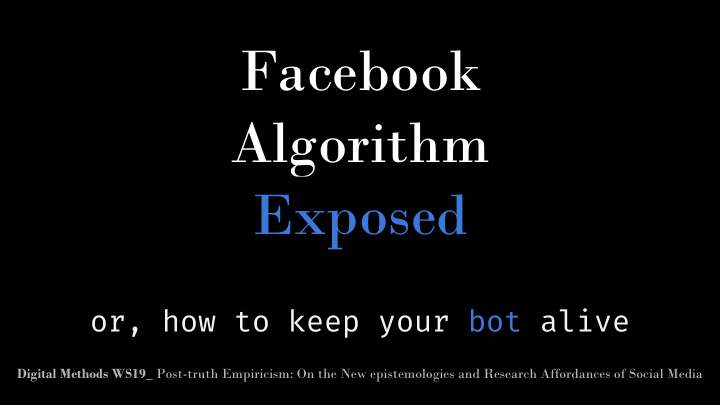



Facebook Algorithm Exposed or, how to keep your bot alive Digital Methods WS19_ Post-truth Empiricism: On the New epistemologies and Research Affordances of Social Media
Research Question How do ‘emotional reactions’ influence the ways in which the Facebook recommendation algorithm curates content that populates the News Feed? Hypothesis Emotional engagement influences the nature of content (frequency, type) that appears on the future News Feed in various ways
Ingredients 1 shady 6 fake 30 pro-brexit 10 top-liked 1 auto-scroller 1 data facebook profiles posts facebook collector algorithm pages (FBTREX)
Method Roos + Sophia 30 pro-Brexit posts auto-scroller FBTREX Tool 10 top-liked facebook pages Maria
Amplification Roos Bernard + + Charlotte (†), Fia Henk (†) Maria Mia FBTREX Tool Liking of auto-scroller liked posts
The Life of a Bot Mia Mia bot was set up to be angry at all posts from 10 pages Facebook blocks bots from certain interactions Humans are required! Increased interaction led to new data but little sharing She gained many friend requests ...
The Life of a Bot Emotional interactions gave us many friend requests Suggests wider bot ecology (to study in future)
Results - The emotions markers became significant (in relation to news feed filtering) only if associated with pages that are already followed/liked - Heart reactions amplified more topical (Brexit) content on the newsfeed while the angry reaction generated less topical content .
Results: Total amount of Pro-Brexit posts 42 % 58 % Bot Maria Bot Roos
Results: Unique Pro-Brexit posts 35 % 42 % 65 % 58 % Bot Roos Bot Maria
Characterizing the filter bubble facebook.tracking.exposed italian elections 2018
Background 3 months italian elections 30 pages publisher_posts (100% of the posts produced by 30 pages, collected with FB Api); bots_impressions (list of posts that actually appeared -possibly multiple times- on the timeline of the bots)
Research Question How does the Facebook algorithm treat differently polarized users?
Research Question How does the Facebook algorithm treat differently polarized users? - How are specific issues differently represented across otherwise polarized bots?
Method *Issues Analysis* 4 issues selected from automatically extracted semantic entities: Labor, European Union, Migration, Family a list of keywords associated to each issue based on highest semantic similarity (word embedding model) contingency table “ Issue by Orientation ” (statistical significance with the Chi Square test)
Issues by orientation Statistically significant (p. < 0.005) difference in the way issues are distributed across different political orientation of the bots
Research Question How does the Facebook algorithm treat differently polarized users? - How are specific issues differently represented across otherwise polarized bots? -Is controversial content differentially boosted across otherwise polarized bots?
Method *Controversy Analysis* degree of controversy of a post looking at the distribution of reactions (proxied with 1 - Gini Heterogeneity Index) most of the reactions of the same type → least ● controversial post ● most of the reactions of different type → most controversial post distribution of controversy index compared across political orientation (statistical significance tested with ANOVA test).
Controversy index Statistically significant (p. < 0.0001) difference in the way controversial posts are distributed across different political orientation of the bots
Research Question How does the Facebook algorithm treat differently polarized users? - How are specific issues differently represented across otherwise polarized bots? - Is controversial content differentially boosted across otherwise polarized bots? - Do filter bubbles select contents based on semantic similarity?
Method *Semantic Analysis* Inquiring semantic similarity with doc2vec (document embedding) m5s right left center-left far right
Results M5s sources M5s impressions (filter bubble)
Conclusions ● We enabled social scientists doing algorithm analysis!
Diversity of needs and skills Thanks to the diversity of the 15 individuals ● we tested new approaches and hypothesis ● Specialization or cross-skills?
This is a beginning! Three structural challenges ●
Many variables Facebook's algorithm requires many variables ● ○ Which makes it hard to control your research setup There are many levels of obfuscation Facebook put in ● place, the only good research Facebook wants is the one which do not ...
Visualize something invisible What is an algorithm? ● ● How can you show the impact of it? How much can it be generalized? ●
Complexity It questions the role we can have as researchers ● questioning the politics of platforms with such public importances. Is it our role to break the ToS and prioritize research? ● ● Is it Facebook’s responsibility to allow structural research to take place outside their own commercial realm?
Recommend
More recommend